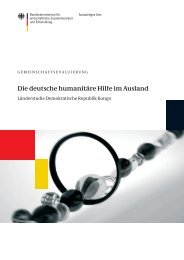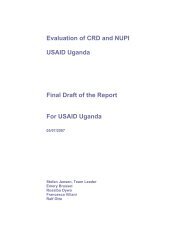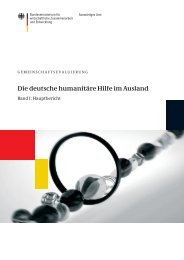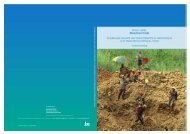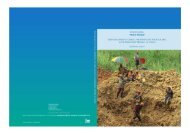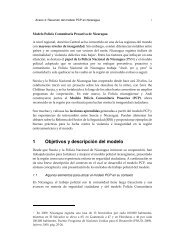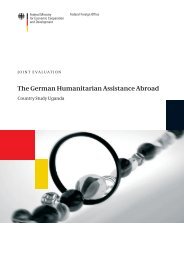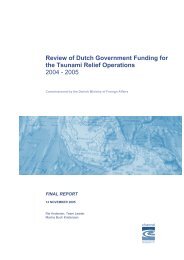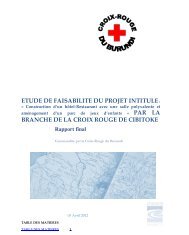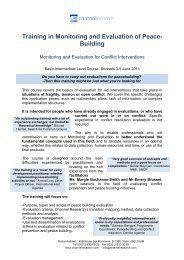A ripple in development? - Channel Research
A ripple in development? - Channel Research
A ripple in development? - Channel Research
You also want an ePaper? Increase the reach of your titles
YUMPU automatically turns print PDFs into web optimized ePapers that Google loves.
not been sufficiently guided <strong>in</strong> reconstruct<strong>in</strong>g their houses, <strong>in</strong> particular<br />
the women. The evaluation observed that both approaches can be<br />
equally successful or unsuccessful accord<strong>in</strong>g to the level of monitor<strong>in</strong>g<br />
and guidance.<br />
4.4 Effect of aid on micro politics and culture<br />
The micro-politics of local social relations 61 have encouraged as well as<br />
h<strong>in</strong>dered recovery. In most cases aid efforts were slow to recognise these<br />
factors and slow to adapt their work to them. An upcom<strong>in</strong>g evaluation<br />
of the research commissioned by the International Development<br />
<strong>Research</strong> Council of Canada around conflict and the tsunami 62 showed<br />
that the distribution of aid has been by far the s<strong>in</strong>gle most important<br />
source of conflict with<strong>in</strong> communities. This is played out through a<br />
number of scenarios, relat<strong>in</strong>g to rent seek<strong>in</strong>g from distribution, the disruption<br />
of social hierarchy, lack of cultural sensitivity, and the <strong>in</strong>appropriate<br />
dist<strong>in</strong>ction on the ground between conflict affected and tsunami<br />
affected populations <strong>in</strong> Indonesia and Sri Lanka.<br />
The <strong>in</strong>terplay with local social structures however occurred <strong>in</strong> different<br />
ways over time. The LRRD1 studies on Indonesia and on Sri<br />
Lanka had described how the use of local structures (the Keuchik, or<br />
village head <strong>in</strong> Aceh, for example), which meant that aid <strong>in</strong>tended for<br />
the more vulnerable would end up re<strong>in</strong>forc<strong>in</strong>g the status of the elite<br />
groups. There appeared to be no effective mechanism to rectify the situation<br />
63 , and the Sri Lanka case study raised concerns regard<strong>in</strong>g the<br />
access to hous<strong>in</strong>g of communities with no land titles 64 .<br />
Shift<strong>in</strong>g to long term rehabilitation has <strong>in</strong> fact addressed these concerns.<br />
The Document Review showed how aid related conflicts registered<br />
by the World Bank <strong>in</strong> Aceh dropped to half of all registered conflicts<br />
after 2005 65 . The <strong>in</strong>terviews carried out <strong>in</strong> the different themes of<br />
the evaluation showed a perception that the poorest had benefited most<br />
from relief assistance (which is different from the po<strong>in</strong>t made as regards<br />
livelihoods, and also different from geographical target<strong>in</strong>g, as here the<br />
issue is <strong>in</strong>tra-community). The survey re<strong>in</strong>forces this message with an<br />
overwhelm<strong>in</strong>g number of respondents (some 85%) say<strong>in</strong>g they were not<br />
affected by corruption.<br />
61<br />
Us<strong>in</strong>g the term<strong>in</strong>ology proposed <strong>in</strong> the ToR<br />
62<br />
“Evaluation of Peace, Conflict and Development <strong>Research</strong> <strong>in</strong> Countries Affected by Violent Conflict,<br />
South Asia Case Study”, Hoffman et al. <strong>Channel</strong> <strong>Research</strong>, draft. Review of the International Centre<br />
for Ethnic Studies project “Post-Tsunami Reconstruction <strong>in</strong> Contexts of War”<br />
63<br />
Evaluation of LRRD Regard<strong>in</strong>g Intervention <strong>in</strong> Connection with the Tsunami, Indonesia Case Study,<br />
p34. <strong>Channel</strong> <strong>Research</strong> for Sida, 2006<br />
64<br />
This study also note: “The evaluation received numerous compla<strong>in</strong>ts of <strong>in</strong>appropriate target<strong>in</strong>g,<br />
<strong>in</strong>clud<strong>in</strong>g reliance on social status, bribery, and lobby<strong>in</strong>g capacity, amongst others, to determ<strong>in</strong>e<br />
beneficiaries of goods and services primarily dur<strong>in</strong>g the post-relief period. Nearly half of respondents<br />
to the LRRD quantitative survey felt that the relief and rehabilitation activities had caused conflict.<br />
A third of the respondents felt that the activities had also caused <strong>in</strong>creased conflict at district<br />
and national levels<br />
65<br />
Document Review, Section 4.2.1 Risks From Conflicts.<br />
80



